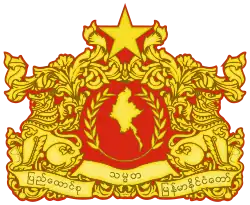1932 Burmese general election
General elections were held in Burma on 9 November 1932,[1] having originally been planned for 29 October.[2] The election was held almost solely on the issue of whether Burma should separate from India,[3] as the British government had indicated that it would take the outcome of the elections as an indication of Burmese opinion.[4] Prior to the elections many of the major parties joined either the Anti-Separation League or the Separation League.
| ||||||||||||||||
80 seats in the Legislative Council 45 seats needed for a majority | ||||||||||||||||
|---|---|---|---|---|---|---|---|---|---|---|---|---|---|---|---|---|
| ||||||||||||||||
| ||||||||||||||||
 |
|---|
| This article is part of a series on the politics and government of Myanmar |
Despite expectations that the separationists would win,[3][1] the Anti-Separation League won a majority of seats. However, the anti-separationists were not in favour of maintaining the union with India, but instead called for a better constitution for a separate Burma.[5] They rejected the constitution proposed by the Prime Minister following the Burma Round-Table Conference, but also rejected the permanent federation with India, and declared they would enter the Indian Federation, but with the right to withdraw.[6]
Campaign
A total of 207 candidates contested the elections;[1] The People's Party headed by U Ba Pe, part of the Separation League, put forward 54, whilst the Independent Party of Joseph Augustus Maung Gyi had 49.[1] Within the Anti-Separation League, the Mawmyintbye Party of Ba Maw and the party led by Chit Hlaing participated in the elections.[7][8]
The Anti-Separation League was well-funded by Indian commercial interests concerned about potential separation, and was backed by Buddhist monks,[9] who the Separation League sought to ban from politics.[4] By contrast, the Separation League was poorly-funded and had little widespread support.[4]
Results
Within the Anti-Separation League the Mawmyintbye Party won the most seats, whilst the People's Party emerged as the largest within the Separation League.[7] The Times noted that the surprise defeat of the separationists was caused by "wild stories" that the country would become a "white man's paradise and home to the British unemployed, that taxation would be heavily increased, even dogs and poultry would be taxed; and that the Buddhist religion would be ruined".[5]
| Party | Votes | % | Seats | |
|---|---|---|---|---|
| Anti-Separation League | 415,000 | 42 | ||
| Separation League | 250,000 | 29 | ||
| Neutrals | 9 | |||
| Total | 80 | |||
| Source: Haruhiro Fukui[10] | ||||
References
- "Separation Issue In Burma To-Day's Election": The Times, 9 November 1932, p11, Issue 46286
- "Burmese Election In October: Separation Finance", The Times, 9 August 1932, p9, Issue 46207
- "Separation Issue In Burma Buddhist Monk's Appeal", The Times, 10 September 1932, p9, Issue 46235
- Haruhiro Fukui (1985) Political parties of Asia and the Pacific, Greenwood Press, p148
- "Burma Election: An Anti-Separation Majority", The Times, 16 November 1932, p14, Issue 46292
- "The New Constitution: Separation from India", The Times, 20 April 1937, p36, Issue 47663
- "Burmese Election Anti-Separationists Decline Office", The Times, 18 November 1932, p13, Issue 46294
- "Deadlock In Burma Office Declined By Parties", The Times, 19 November 1932, p9; Issue 46295
- Fukui, pp113–114
- Fukui, pp106–154

